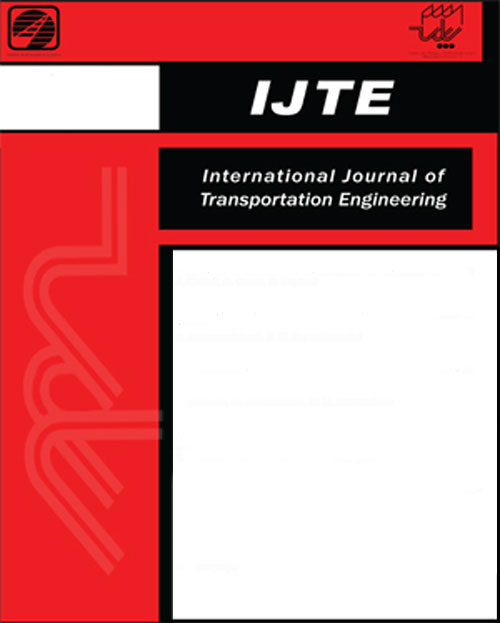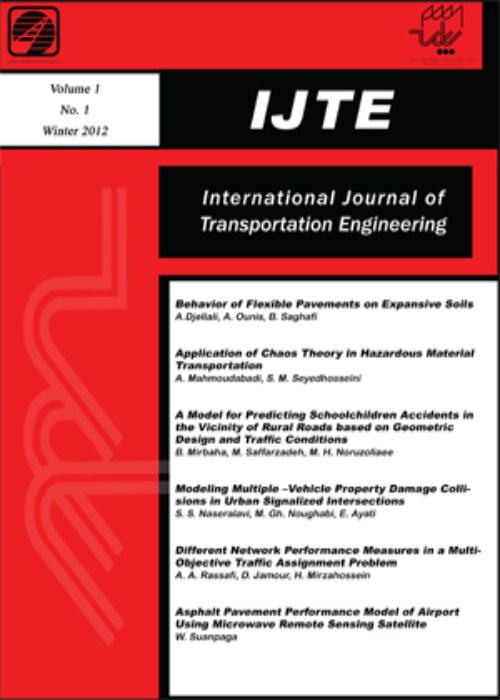فهرست مطالب

International Journal of Transportation Engineering
Volume:4 Issue: 1, Summer 2016
- تاریخ انتشار: 1395/08/11
- تعداد عناوین: 6
-
-
Pages 1-8This paper explores the effects of trip purpose on price elasticity of bus mode. Data for the research was collected through passenger field survey in Isfahan, Iran. Due to the nature of the data, nonlinear regression and nonparametric statistics tools were used for analysis. It was found that the logarithmic function best explains the relationship between percentage of change in demand and percentage of change infare. This implies that increase in the fare has a diminishing return to scale on demand. Average values of elasticity were calculated as (-0.33) for educational trips, (-0.27) for shopping trips, (-0.26) for commuting trips, (-0.66) for leisure trips, (-0.26) for medical trips, (-0.35) for returning-to-home trips, and (-0.54) for other trips. Highest values were observed for leisure trips and lowest values for shopping and commuting trips. Kruskal-Wallis and Mann-Whitney U test were employed to analyze the equity of elasticity values among trip purposes. Results show that differences are significant and therefore, trip purpose does have significant effect on the value of fare elasticity of transit demand.Keywords: Transit, demand elasticity, trip purpose, nonparametric test
-
Pages 9-26In present study, a mathematical model of the vehiclefloating slab track (FST) interaction is established to investigate the coupled behaviour of vehicletrack system. The FST is modelled as the double Euler -Bernoulli beam including the rail and slab. The railway vehicle is simplified as a multi-rigid-body model. The wheelrail interface is treated using a nonlinear Hertzian contact model, coupling the mathematical equations of the vehicleFST systems. The dynamic interaction of the entire system is numerically studied in time domain, employing Newmarks integration method. The numerical model of the present research is validated using benchmark model reported in the literature. Finally using the developed numerical tool many sensitivity analyses were performed on various important parameters affecting on dynamic behaviour of slab track, such as slab thickness, axle load and the track bed stiffness and consequently the deflection and bending moment of rail and slab were assessed. Slab thickness has more effect on slab than rail dynamic behaviour.Keywords: Vehicle, FST Interaction, Double Euler Bernoulli beam, Dynamic Response
-
Pages 27-39Researches using existing statistics and data collected from the area of study help officials at decision-making, to improve the region's problems, like the problem of the high rate of accidents in the region, despite the low volume of daily service. The uses of roundabouts in many parts of the world have many advantages over intersections, amongst them are increased safety and capacity and reduced cost. To improve roundabout function, roundabout traffic control and vehicle safety, informed decision-making from studies carried out is required. Roundabout design for Capacity and safety are inseparable components, due to the conditions of roundabout geometry, traffic sign, pavement conditions and patterns of drivers behavior change. The aim of this study was to evaluate the importance and influence of these parameters on the behavior of drivers. In this research, the effect of Pavement Condition Index (PCI), Contrast of roundabout lane lines color and volume-to-capacity ratio on the value of obeying the rules of the road for drivers (using turn signals and avoiding unnecessary lane change at roundabout) were evaluated. Data was gathered through field research of seven roundabouts in the city of Yazd, Iran. Statistical methodologies (t-test method and bivariate regression) and the CART model were used for data analysis. Results show when Pavement Condition Index (PCI) improves, unnecessary lane changes by drivers at the roundabout decrease. Similarly, the use of turn signal increases with an increase in the volume-to-capacity ratio, so in the roundabouts with a higher volume-to-capacity ratio of 0.58, 47.5% of drivers use turn signals, while with a less volume-to-capacity ratio of 0.58, the rate of using turn signal will be less than this amount (11.7%).This suggests the need for policy-making at roundabout with low volume-to-capacity ratio, to encourage the use of turn signals by drivers. The results of this research can help city managers and traffic police to prioritize traffic control and reform municipal roundabouts.Keywords: Decision, making, two, lane roundabout, Pavement Condition Index, Contrast of traffic lane lines color, CART model
-
Pages 41-52Nowadays, traffic management policy in metropolitans is focused on increasing the share of public transit. The limitation of supply and slowing growth of road infrastructures have provided congestion for users who choose personal cars. Therefore, applying demand management policies which decrease the utility of personal cars and increase the tendency to public transit can be very important. Congestion pricing is a concept from market economics regarding the use of pricing mechanisms. One of the main questions is the effect of pricing strategy on mode choice behavior of users. This paper aims to investigate the effects of congestion pricing on choosing transit among people. Since direct observation of the pricing scenarios is impossible, stated preference approach has been used. Scenarios of pricing based on empirical design are provided and distributed among the respondents. The questionnaire included socio-economic and trip characteristics of the respondents. Based on the pricing scenarios, three choices including "personal car", "public transit, and "other modes were included. More than 3500 questionnaire are gathered and coded. For modeling, the multinomial logit has been applied and calibrated for every choice. The results show that pricing can be used as an appropriate tool for demand management and encouraging users to choose public transit. Setting 30000 IRR1 entrance toll causes 13 percent change in modal shift from personal car to public transit. Finally, the model results at various costs have been discussed.Keywords: Mode choice, Congestion pricing, stated preference survey
-
Pages 53-59Temporal coordination of services, as a crucial aspect of integration in public transport systems, has always been a big concern for transit planners and schedulers. One of the major issues in the way of coordinating transit services is the lack of a robust measure of effectiveness for assessing the quality of temporal coordination in public transport systems. Even though the network-wide summation of transfer waiting times is commonly used as a measure for this purpose, this index is not always calculable particularly when transferring passengers count is unavailable. This paper aims to present a practical method for quantifying the level of temporal coordination in transit systems, even in the absence of transfers count data. In this paper, first the timetable coordination indices proposed in the literature are evaluated and discussed. Then, a quantitative index is mathematically developed based on the actual waiting time incurred by transferring passengers in transit systems. A numerical example is also presented to examine the applicability of the proposed index. The results of this application revealed this index could be reliably used as a measure of effectiveness for assessing the level of coordination between public transport services, as well as for evaluating the impacts of different timetabling scenarios on transit systems integration.Keywords: Transit, public transport, synchronisation, timetable, schedule
-
Pages 61-74Driver's behavior is one of the most important factors in traffic safety. Understanding of this issue and its effective factors can be helpful to reduce the influences of human factors on traffic accidents. The objective of this study is to apply Manchester driver behavior questionnaire (DBQ) to a group of drivers who have overtaken on two-lane rural roads and to analyze their behavior. Also, the relationship between DBQ subscales and overtaking type is investigated.Data collection was performed using field method (observations next to the roads). In order to analyze the data, factor analysis, analysis of variance, and logistic regression were used. Factor analysis led to producing a 4-factor structure including errors, lapses, ordinary violations, and aggressive violations. The results showed that increasing in age and driving experiences gave rise to a decrease in violations scores. Moreover, the results demonstrated a relationship between demographic variables, the score of violations, and type of overtaking. In addition, older drivers had low tendency to commit violations. The purpose of the trip was one of the effective factors for driver's behavior and types of driver's overtaking maneuver. Drivers who were on business trips committed more violations and errors than others. Among DBQ factors only the violation factor was effective for predicting the type of overtaking.Keywords: Driver behavior questionnaire, two, lane, two, way rural roads, overtaking


